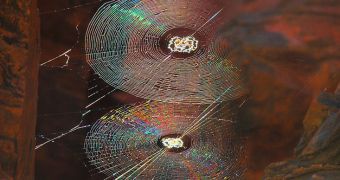When it comes to mimicking nature, researchers oftentimes find themselves in a bind. This is especially true for structures such as gecko feet and spider webs, both of which take “natural engineering” to new extremes. Spider silk is, for example, known to be one of the strongest materials out there today. When compared to human-built materials of its size, it performs better than steel and Kevlar, while also maintaining its elasticity and so on. Scientists have been trying to derive methods of replicating spider webs for many years, but thus far their efforts have failed. Now, a new study highlights one of the reasons why. LiveScience reports.
In the new investigation, scientists managed to shed more light on one of the most mysterious aspects of spider web production, and namely how a very special protein gets converted into the stuff as soon as the spider pleases it. These proteins have been found in previous studies to exist in liquid form, and yet they somehow get transformed in wires with a tensile strength five times higher than that of steel. Tensile strength is a measure of the stretching capabilities a material has. Its maximum strength is determined in the moment immediately before it breaks under the applied strain. The best artificially-produced fibers today have a tensile strength three times lower than that of spider web.
“The high elasticity and extreme tensile strength of natural spider silk are unmatched, even by fibers produced from pure spider silk proteins,” explains Technische Universitaet Muenchen (TUM) Institute for Advanced Study (IAS) professor Horst Kessler. What the investigator and his group sought to determine was the mechanism that spiders employed in keeping the components of their future webs at their disposal at all times. The proteins that go into the silk have to be always maintained in very high concentrations, so as to allow the creature to spin its web whenever it pleases. Given the nature of the proteins making up the silk, researchers were curious to learn precisely how the animal avoided tangling these molecules inside it before being produced.
“Under storage conditions in the silk gland these control domains are connected pair-wise in such a way that the interlinking areas of both chains cannot lie parallel to each other. Interlinking is thus effectively prevented,” says University of Bayreuth scientist Thomas Scheibel, who was also a researcher on the new investigation, details of which appear in the May 13 issue of the esteemed scientific journal Nature. The team explains that the situation changes as soon as the proteins go into the spinning duct. Here, varied salt and liquid concentrations force the proteins together, producing the web that the spider then lays as it pleases.

 14 DAY TRIAL //
14 DAY TRIAL //